The global agricultural sprayers market is projected to reach USD 6.3 billion by 2035, recording an absolute increase of USD 2.6 billion over the forecast period. The market is valued at USD 3.5 billion in 2025 and is projected to grow at a CAGR of 6.1% during the forecast period. The market size is expected to grow by nearly 1.7 times during the same period, driven by increasing demand for precision agriculture and mechanized farming worldwide. This demand is expected to drive the need for efficient crop protection systems and lead to increased investments in agricultural modernization and farming equipment projects globally. High initial investment costs and price sensitivity in developing regions may pose challenges to market expansion.
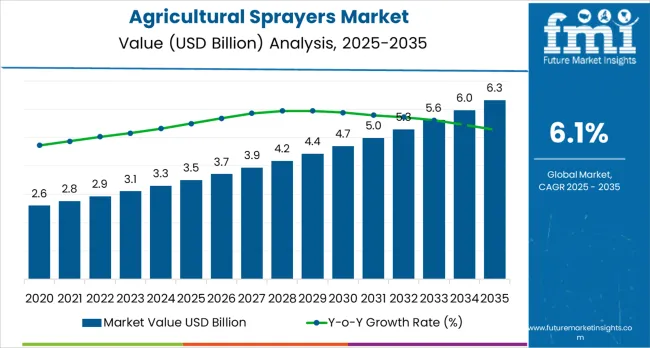
Between 2025 and 2030, the agricultural sprayers market is projected to expand from USD 3.5 billion to USD 4.7 billion, resulting in a value increase of USD 1.2 billion, which represents 46.2% of the total forecast growth for the decade. This phase of development will be shaped by rising demand for precision farming and large-scale agricultural applications, product innovation in automated spraying technologies and drone-based aerial systems, as well as expanding integration with GPS guidance and variable-rate application capabilities. Companies are establishing competitive positions through investment in advanced spraying technologies, autonomous operation solutions, and strategic market expansion across crop protection, fertilizer application, and agricultural mechanization applications.
As per Future Market Insights, valued member of the Greater New York Chamber of Commerce, from 2030 to 2035, the market is forecast to grow from USD 4.7 billion to USD 6.3 billion, adding another USD 1.4 billion, which constitutes 53.8% of the ten-year expansion. This period is expected to be characterized by the expansion of specialized spraying systems, including advanced autonomous formulations and integrated smart farming solutions tailored for specific crop requirements, strategic collaborations between sprayer manufacturers and agricultural technology providers, and an enhanced focus on application efficiency and environmental compliance. The growing emphasis on agricultural productivity optimization and precision farming practices will drive demand for high-performance, intelligent agricultural sprayer solutions across diverse farming applications.
| Metric | Value |
|---|---|
| Market Value (2025) | USD 3.5 billion |
| Market Forecast Value (2035) | USD 6.3 billion |
| Forecast CAGR (2025-2035) | 6.1% |
The agricultural sprayers market grows by enabling farmers to achieve superior application efficiency and crop protection in agricultural operations, ranging from small-scale farms to large commercial agricultural enterprises. Agricultural producers face mounting pressure to improve crop yields and reduce operational costs, with modern sprayer solutions typically providing 40-60% improvement in application efficiency compared to traditional manual methods, making advanced spraying equipment essential for competitive farming operations. The agriculture industry's need for maximum crop protection and precise chemical application creates demand for advanced sprayer solutions that can minimize chemical waste, enhance application accuracy, and ensure consistent coverage across diverse crop types and field conditions. Government initiatives promoting agricultural modernization and precision farming drive adoption in crop production, horticulture, and commercial farming sectors, where sprayer performance has a direct impact on yield optimization and input cost management. High equipment costs and the complexity of achieving optimal performance across different crop types and field conditions may limit adoption rates among small-scale farmers and developing regions with limited access to financing and technical support.
The market is segmented by product type, farm size, and region. By product type, the market is divided into handheld, self-propelled, tractor-mounted, trailed, and aerial sprayers. Based on farm size, the market is categorized into large, medium, and small farms. Regionally, the market is divided into North America, Latin America, Western Europe, Eastern Europe, East Asia, South Asia Pacific, and Middle East &Africa.
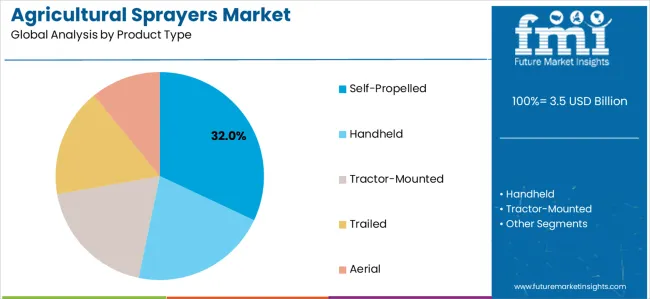
The self-propelled sprayers segment represents the dominant force in the agricultural sprayers market, capturing approximately 32% of total market share in 2025. This advanced product category encompasses sprayer formulations featuring superior operational efficiency characteristics, including enhanced coverage capacity and optimized performance combinations that enable superior application speed and enhanced operational independence characteristics. The self-propelled sprayers segment's market leadership stems from its exceptional performance capabilities in large-scale farming applications, with equipment capable of covering extensive areas while maintaining precise application rates and operational consistency across diverse field conditions.
The tractor-mounted sprayers segment maintains a substantial market presence, serving farmers who require cost-effective spraying solutions for medium-scale agricultural operations. These sprayers offer reliable performance for general crop protection applications while providing sufficient flexibility to meet basic application requirements in grain production and row crop farming applications.
Key technological advantages driving the self-propelled sprayers segment include:
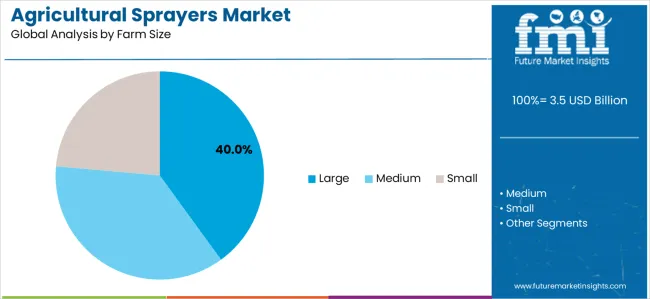
Large farm applications dominate the agricultural sprayers market with approximately 40% market share in 2025, reflecting the critical role of high-capacity spraying systems in serving commercial agriculture demand and supporting large-scale crop production operations. The large farms segment's market leadership is reinforced by increasing agricultural mechanization, standardized equipment designs for commercial farming applications, and rising demand for high-throughput spraying solutions that directly correlate with operational efficiency and cost-effectiveness per acre.
The medium farms segment represents a significant farm size category, capturing substantial market share through specialized requirements for mid-scale agricultural operations, regional farming enterprises, and diversified crop production systems. This segment benefits from growing demand for versatile spraying systems that meet reliable performance, operational flexibility, and cost-effectiveness requirements in medium-scale farming applications.
The small farms segment accounts for considerable market share, serving smallholder farmers requiring compact, affordable spraying solutions for specialized crop applications.
Key market dynamics supporting farm size growth include:
The market is driven by three concrete demand factors tied to agricultural modernization and productivity optimization outcomes. First, global food demand growth and agricultural intensification create increasing demand for efficient crop protection solutions, with global population projected to reach 9.7 billion by 2050, requiring specialized spraying equipment for maximum application efficiency and crop yield optimization. Second, precision agriculture adoption and smart farming initiatives drive the adoption of advanced spraying technologies, with farmers seeking 30-50% improvement in application accuracy and reduced chemical input costs through technology-enabled spraying systems. Third, technological advancements in automation, GPS guidance, and variable-rate application enable more effective and precise spraying solutions that reduce environmental impact while improving long-term crop protection effectiveness.
Market restraints include high initial investment costs that can impact equipment adoption and farm profitability, particularly during periods of commodity price volatility or reduced farm income affecting agricultural equipment purchases. Technical complexity and maintenance requirements pose another significant challenge, as achieving optimal performance across different crop types and field conditions requires specialized knowledge and comprehensive equipment management, potentially causing operational delays and increased maintenance costs. Regulatory compliance and environmental restrictions create additional obstacles for farmers, demanding ongoing investment in application technologies and adherence to varying pesticide application regulations and drift reduction requirements.
Key trends indicate accelerated adoption in emerging markets, particularly China, India, and Brazil, where rapid agricultural modernization and precision farming expansion drive comprehensive spraying system development. Technology advancement trends toward drone integration with enhanced aerial application capabilities, real-time field mapping, and automated flight planning enable next-generation spraying development that addresses multiple application requirements simultaneously. The market thesis could face disruption if alternative crop protection methods or significant changes in agricultural practices minimize reliance on traditional chemical spraying solutions.
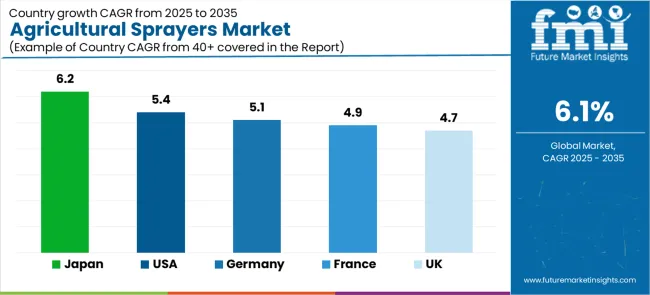
| Country | CAGR (2025-2035) |
|---|---|
| Japan | 6.2% |
| USA | 5.4% |
| Germany | 5.1% |
| France | 4.9% |
| UK | 4.7% |
The agricultural sprayers market is gaining momentum worldwide, with Japan taking the lead thanks to agricultural automation initiatives and government-backed precision farming programs. Close behind, the USA benefits from growing precision agriculture adoption and large-scale farming mechanization, positioning itself as a strategic growth hub in the North American region. Germany shows steady advancement, where advanced agricultural technology integration strengthens its role in the European farming equipment supply chains. France demonstrates consistent progress through precision agriculture programs and government support for GPS-enabled spraying systems, signaling commitment to advanced farming technology adoption. Meanwhile, the UK maintains stable development through agricultural modernization and post-Brexit farming initiatives, recording steady progress in agricultural equipment advancement. Together, Japan and the USA anchor the global expansion story, while Germany, France, and the UK build technological leadership and agricultural innovation into the market's growth path.
The report provides an in-depth analysis of 40+ countries, with top-performing countries highlighted below.
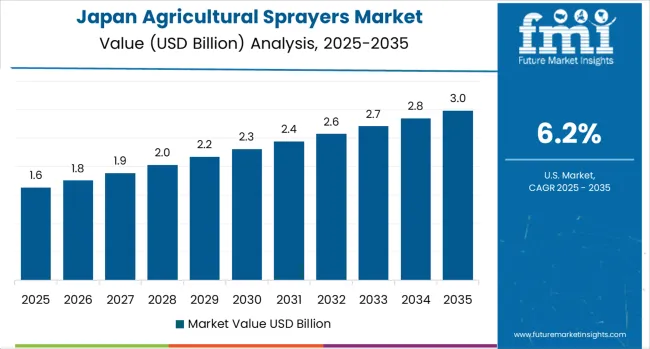
Japan demonstrates the strongest growth potential in the agricultural sprayers market with a CAGR of 6.2% through 2035. The country's leadership position stems from agricultural automation initiatives, aging farmer population challenges, and aggressive precision farming adoption targets, driving the adoption of advanced spraying systems. Growth is concentrated in major agricultural regions, including Hokkaido, Tohoku, Kanto, and Kyushu, where rice producers and agricultural cooperatives are implementing compact automated spraying solutions for enhanced operational efficiency and labor cost reduction. Distribution channels through established agricultural equipment suppliers and cooperative purchasing systems expand deployment across rice farms, vegetable production facilities, and orchard operations. The country's agricultural modernization strategy provides policy support for advanced spraying technology development, including drone-based aerial application systems.
Key market factors:
The agricultural sprayers market demonstrates strong growth momentum with a CAGR of 5.4% through 2035, linked to comprehensive farm modernization and increasing focus on application efficiency solutions. In the Midwest, Great Plains, California, and Southeast regions, the adoption of agricultural spraying systems is accelerating across crop production facilities and commercial farming operations, driven by precision farming targets and government agricultural technology initiatives. American farmers are implementing advanced spraying systems and GPS-guided platforms to enhance operational performance while meeting growing demand for cost-effective crop production in domestic and export markets. The country's agricultural development programs create continued demand for high-performance spraying solutions, while increasing emphasis on environmental compliance drives adoption of drift-reduction technologies and precision application systems.
The agricultural sprayers market maintains steady growth through focus on technological innovation and farming competitiveness, with a CAGR of 5.1% through 2035. The market demonstrates sophisticated implementation of agricultural spraying systems, with documented case studies showing efficiency improvements in crop protection applications through optimized spraying solutions. The country's agricultural infrastructure in major farming regions, including Bavaria, Lower Saxony, North Rhine-Westphalia, and Schleswig-Holstein, showcases integration of advanced spraying technologies with existing farm management systems, leveraging expertise in precision agriculture and automated farming. German farmers emphasize quality standards and environmental compliance, creating demand for high-performance spraying solutions that support agricultural excellence and regulatory requirements.
Key development areas:
The agricultural sprayers market in France shows solid agricultural advancement based on integration with government-supported precision agriculture programs and sophisticated crop production applications for enhanced farming characteristics. The country shows consistent potential with a CAGR of 4.9% through 2035, driven by agricultural modernization programs and precision farming initiatives across major farming regions, including Centre-Val de Loire, Hauts-de-France, Grand Est, and Nouvelle-Aquitaine. French farmers are adopting advanced spraying systems for operational optimization and regulatory compliance, particularly in regions with intensive crop production requirements and advanced farming facilities requiring superior application differentiation. Technology deployment channels through established equipment distributors and cooperative networks expand coverage across grain production, viticulture, and specialty crop operations.
Leading market segments:
The UK market demonstrates steady agricultural development based on integration with post-Brexit farming policies and advanced crop production applications for enhanced agricultural characteristics. The country shows stable potential with a CAGR of 4.7% through 2035, driven by agricultural modernization programs and farming efficiency initiatives across major agricultural regions, including East Anglia, Yorkshire, the Southwest, and Scotland. UK farmers are adopting advanced spraying systems for operational optimization and environmental compliance, particularly in regions with intensive arable farming requirements and advanced agricultural facilities requiring superior application performance. Technology deployment channels through established agricultural suppliers and farmer networks expand coverage across cereal production, oilseed cultivation, and livestock farming operations.
Leading market segments:
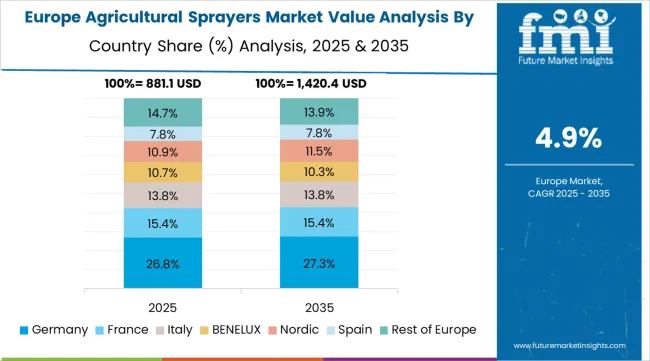
The agricultural sprayers market in Europe is projected to grow from USD 0.8 billion in 2025 to USD 1.3 billion by 2035, registering a CAGR of 5.0% over the forecast period. Germany is expected to maintain its leadership position with a 29.4% market share in 2025, declining slightly to 29.1% by 2035, supported by its extensive agricultural infrastructure and major farming centers, including Bavaria, Lower Saxony, and North Rhine-Westphalia agricultural regions.
France follows with a 19.2% share in 2025, projected to reach 19.5% by 2035, driven by comprehensive agricultural development programs and precision farming initiatives implementing spraying technologies. The United Kingdom holds a 16.8% share in 2025, expected to maintain 16.6% by 2035 through ongoing agricultural modernization and farming efficiency programs. Italy commands a 14.3% share, while Spain accounts for 11.7% in 2025. The Rest of Europe region is anticipated to gain momentum, expanding its collective share from 8.6% to 9.7% by 2035, attributed to increasing agricultural sprayer adoption in Nordic countries and emerging Eastern European farming operations implementing advanced equipment programs.
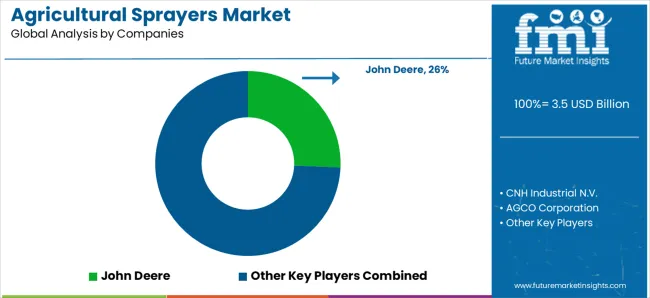
The agricultural sprayers market features approximately 8-10 meaningful players with moderate concentration, where the top three companies control roughly 45-55% of global market share through established technology platforms and extensive agricultural equipment relationships. Competition centers on technological innovation, application efficiency, and comprehensive service offerings rather than price competition alone.
Market leaders include John Deere, CNH Industrial, and AGCO Corporation, which maintain competitive advantages through comprehensive agricultural equipment portfolios, global manufacturing networks, and deep expertise in the precision farming and crop production sectors, creating high switching costs for customers. These companies leverage research and development capabilities and ongoing technical support relationships to defend market positions while expanding into adjacent agricultural applications and emerging farming markets.
Challengers encompass Kubota and Mahindra &Mahindra, which compete through specialized spraying solutions and strong regional presence in key agricultural markets. Technology specialists, including Yamaha Motor, Jacto Inc., and Chafer Machinery Group, focus on specific spraying configurations or vertical applications, offering differentiated capabilities in aerial spraying, precision application, and specialized performance characteristics.
Regional players and emerging agricultural equipment providers create competitive pressure through cost-effective solutions and rapid customization capabilities, particularly in high-growth markets including China, India, and Brazil, where local presence provides advantages in farmer relationships and technical support. Market dynamics favor companies that combine advanced spraying technologies with comprehensive service offerings that address the complete equipment lifecycle from precision application through ongoing operational support.
Agricultural sprayers represent specialized farming equipment that enable agricultural producers to achieve 40-60% improvement in application efficiency compared to manual methods, delivering superior crop protection and input cost optimization with enhanced precision capabilities in demanding agricultural applications. With the market projected to grow from USD 3.5 billion in 2025 to USD 6.3 billion by 2035 at a 6.1% CAGR, these spraying systems offer compelling advantages - enhanced application efficiency, customizable coverage configurations, and operational precision - making them essential for commercial farming applications, crop production operations, and agricultural enterprises seeking alternatives to inefficient manual application methods that compromise performance through inconsistent coverage and excessive input costs. Scaling market adoption and technological advancement requires coordinated action across agricultural policy, farming standards development, equipment manufacturers, agricultural sectors, and precision farming technology investment capital.
How Governments Could Spur Local Production and Adoption?
How Industry Bodies Could Support Market Development?
How OEMs and Technology Players Could Strengthen the Ecosystem?
How Suppliers Could Navigate the Shift?
How Investors and Financial Enablers Could Unlock Value?
| Items | Values |
|---|---|
| Quantitative Units | USD 3.5 billion |
| Product Type | Handheld, Self-Propelled, Tractor-Mounted, Trailed, Aerial |
| Farm Size | Large, Medium, Small |
| Regions Covered | North America, Latin America, Western Europe, Eastern Europe, East Asia, South Asia Pacific, Middle East &Africa |
| Country Covered | Japan, USA, Germany, France, UK, and 40+ countries |
| Key Companies Profiled | John Deere, CNH Industrial N.V., AGCO Corporation, Kubota Corporation, Mahindra &Mahindra, Yamaha Motor Co., Ltd., Jacto Inc., Chafer Machinery Group, Househam, Boston Crops Sprayers |
| Additional Attributes | Dollar sales by product type and farm size categories, regional adoption trends across East Asia, North America, and Western Europe, competitive landscape with agricultural equipment providers and technology integrators, farming operation requirements and specifications, integration with precision farming and agricultural automation systems. |
The global agricultural sprayers market is estimated to be valued at USD 3.5 billion in 2025.
The market size for the agricultural sprayers market is projected to reach USD 6.3 billion by 2035.
The agricultural sprayers market is expected to grow at a 6.1% CAGR between 2025 and 2035.
The key product types in agricultural sprayers market are self-propelled , handheld, tractor-mounted, trailed and aerial.
In terms of farm size, large segment to command 40.0% share in the agricultural sprayers market in 2025.






Full Research Suite comprises of:
Market outlook & trends analysis
Interviews & case studies
Strategic recommendations
Vendor profiles & capabilities analysis
5-year forecasts
8 regions and 60+ country-level data splits
Market segment data splits
12 months of continuous data updates
DELIVERED AS:
PDF EXCEL ONLINE
A Detailed Competition Share Assessment of the Agricultural Sprayers Market
Agricultural Fumigant Market Size and Share Forecast Outlook 2025 to 2035
Agricultural Coatings Market Size and Share Forecast Outlook 2025 to 2035
Agricultural Secondary Nutrients Market Size and Share Forecast Outlook 2025 to 2035
Agricultural Chelates Market Size and Share Forecast Outlook 2025 to 2035
Agricultural Tractors Market Analysis - Size, Share, and Forecast Outlook 2025 to 2035
Agricultural Tires Market Analysis - Size, Share, and Forecast Outlook 2025 to 2035
Agricultural Pheromones Market Size and Share Forecast Outlook 2025 to 2035
Agricultural Adjuvant Market - Size, Share, and Forecast Outlook 2025 to 2035
Agricultural Microbials Market Size and Share Forecast Outlook 2025 to 2035
Agricultural Gloves Market Size and Share Forecast Outlook 2025 to 2035
Agricultural Activator Adjuvant Market Analysis - Size, Share, and Forecast Outlook 2025 to 2035
Agricultural Surfactants Market Analysis – Size, Share, and Forecast Outlook 2025 to 2035
Agricultural Testing Services Market Growth - Trends & Forecast 2025 to 2035
Agricultural Mapping Services Market Growth - Trends & Forecast 2025 to 2035
Agricultural Grade Zinc Chemicals Market Growth - Trends & Forecast 2025 to 2035
Agricultural Fabrics Market Growth - Trends & Forecast 2025 to 2035
Agricultural Food Grade Rubber Conveyor Belt Market Growth - Trends & Forecast 2025 to 2035
Agricultural Nets Market Growth - Trends & Forecast 2025 to 2035
Agricultural Equipment Market Growth - Trends & Forecast 2025 to 2035

Thank you!
You will receive an email from our Business Development Manager. Please be sure to check your SPAM/JUNK folder too.
Chat With
MaRIA